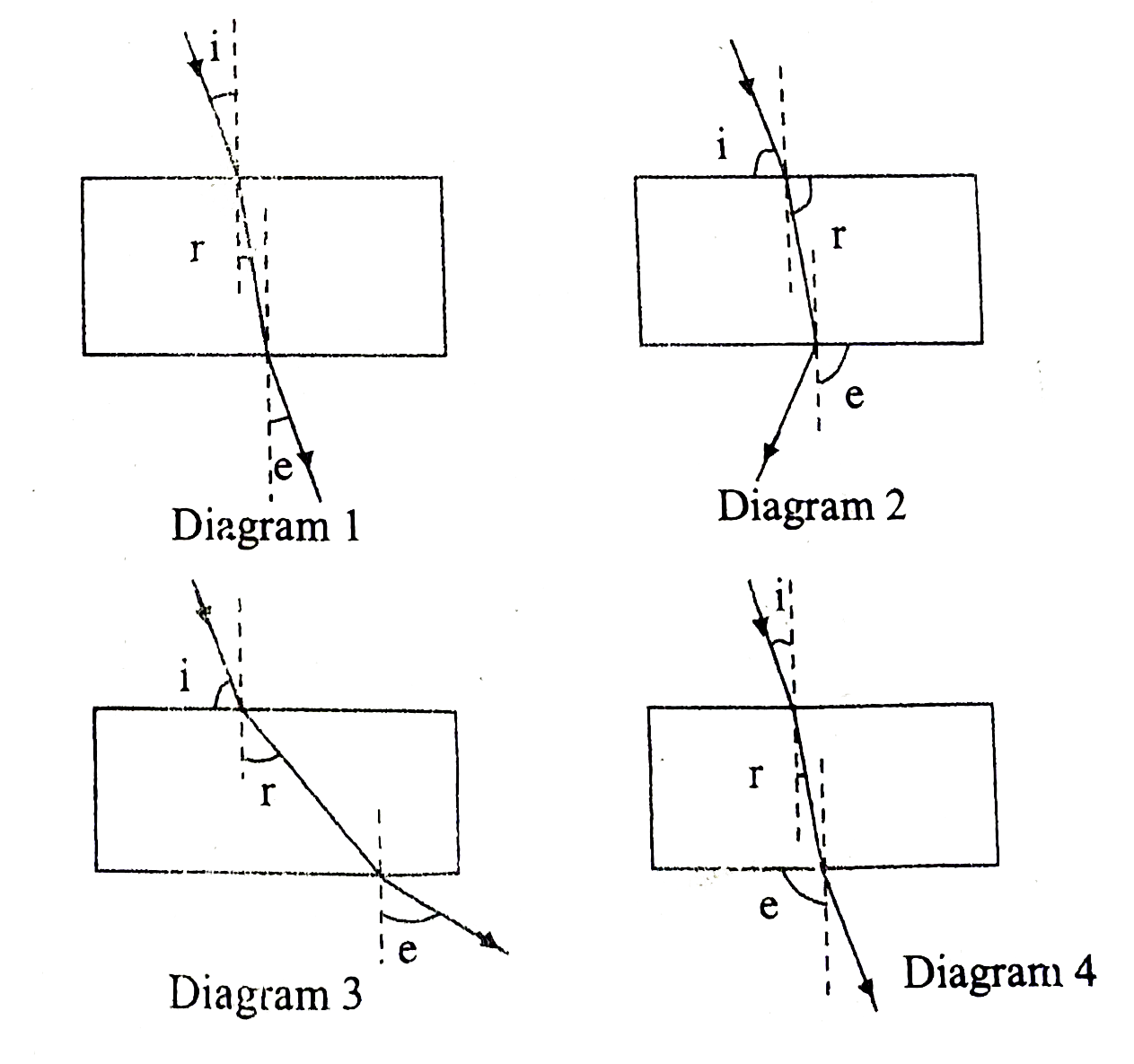In an experiment, the path of a ray of light passing through a rectangular glass slab was traced by a student. Which of the following diagram shows correct measurement of angle of incidence (i), refraction (r ), and emergence (e ) ?

Diagram 1
Diagram 2
Diagram 3
Diagram 4
The correct Answer is:A
Step by step video & image solution for In an experiment, the path of a ray of light passing through a rectangular glass slab was traced by a student. Which of the following diagram shows correct measurement of angle of incidence (i), refraction (r ), and emergence (e ) ? by Physics experts to help you in doubts & scoring excellent marks in Class 10 exams.
Updated on:21/07/2023Topper's Solved these Questions
- Refraction of lightBOOK - TARGET PUBLICATIONCHAPTER - Refraction of lightEXERCISE - Complete the paragraph
1 Videos
- Refraction of lightBOOK - TARGET PUBLICATIONCHAPTER - Refraction of lightEXERCISE - Name the following
7 Videos
- Refraction of lightBOOK - TARGET PUBLICATIONCHAPTER - Refraction of lightEXERCISE - Solve the following problems
8 Videos
- MODEL QUESTION PAPER PART-2BOOK - TARGET PUBLICATIONCHAPTER - MODEL QUESTION PAPER PART-2EXERCISE - QUESTIONS
2 Videos
- SOCIAL HEALTH BOOK - TARGET PUBLICATIONCHAPTER - SOCIAL HEALTH EXERCISE - CHAPTER ASSESSMENT
3 Videos
Similar Questions
An experiment to trace the path of a ray of light through a rectangular glass slab was performed by four students I, II, III, IV. They reported the following measurements of angle of incidence __ angle of refraction ___ and angle of emergence __ Which one of the students has performed the experiment correctly ?

View SolutionA ray of light passes through a rectangular glass block placed in air. Which diagram shows a possible path of a ray?

View Solution
Knowledge Check
In an experiment to trace the path of a ray of light passing through a rectangular glass slab, four students measured the angles of incidence (i), angles of refraction (r) and angles of emergence (e) as shown in the diagrams :

The correct measurement is given in the diagram :AABBCCDDIn the experiment on tracing the path of a ray of light passing through a rectangular glass slab, the correct setting of the protractor (D), for measuring the angle of incidence (∠I), and the angle of emergence (∠e) correspond, respectively, to diagrams :
 AK and MBK and NCL and MDL and N
AK and MBK and NCL and MDL and NA student performs the experiment on tracing the path of a ray of light passing through a rectangular glass slab for different angles of incidence. He measures the angle of incidence ∠i, angle of refraction ∠r and angle of emergence ∠e for all his observations. He would find that in all cases :
A∠i is more than ∠r but (nearly) equal to ∠eB∠i is less than ∠r but (nearly) equal to ∠eC∠i is more than ∠e but (nearly) equal to ∠rD∠i is less than ∠e but (nearly) equal to ∠r
In an experiment to trace the path of a ray of light passing through a rectangular glass slab, angle of incidence in air was given as 60∘ . Two students P and Q found angle of refraction as 42∘ and 65∘ respectively. Who is right and why?
View SolutionIn an experiment to trace the path of a ray of light passing through a rectangular glass slab, angle of incidence in air was given as 60∘ . Two students P and Q found angle of refraction as 42∘ and 65∘ respectively. Who is right and why?
View SolutionA student does the experiment on tracing the path of a ray of light passing through a rectangular glass slab for different angles of incidence. He can get a correct measure of the angle of incidence and the angle of emergence by following the labelling indicated in figure :

View SolutionIn an experiment to trace the path of a ray of light through a triangular glass prism, a student would observe that the emergent ray
View SolutionA teacher asked four students to record the observations of the experiment on tracing the path of a ray of light through a rectangular glass slab. The students recorded their observations under the following headings :
(1) Angle of incidence, Angle of refraction, Angle of reflection
(2) Angle of incidence, Angle of deviation, Angle of emergence
(3) Angle of incidence, Angle of reflection, Angle of emergence
(4) Angle of incidence, Angle of refraction, Angle of emergence
The correct observations were recorded by the student :
View Solution
